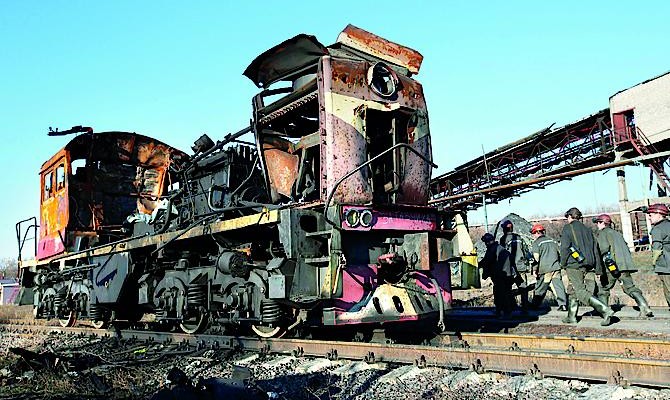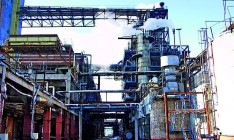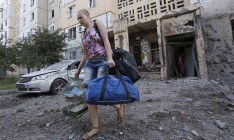Economy
tradeThe war in the Donbas region is costing more than the loss of Crimea

Export of Ukrainian commodities fell by US $4.3 bn over three quarters of 2014. Russia can be blamed for the loss of US $3.7 bn – which is the amount of shrinkage of shipment of goods abroad from Crimea and the Donbas region.
Strictly speaking, the annexation of Crimea was not a major loss for Ukraine’s foreign trade. The peninsula provided less than 2% of the export of domestic goods. But this cannot be said about the territory that became a military base for the conflict between Russia and Ukraine. Back in 2013, the Donetsk and Luhansk oblasts accounted for one fourth of the deliveries of goods from Ukraine abroad. However, the military actions led to a 25% decline in exports from these regions, which is US $3 bn over three quarters of 2014 compared to the same period last year.
Prohibition
Crimea mainly specializes in growing of food products and distilling of alcoholic beverages. According to statistics of the State Statistics Service, last year Crimea produced 37% of wines, 34% of cognac and 20% of vodka in Ukraine. At the same time, Crimea accounted for only 7% of the export of alcohol, non-alcoholic beverages and vinegar.
In March, the new government in Crimea nationalized the Maharach and Massandra wineries and the Noviy Svit champagne plant, which up until then were owned by Ukraine. Private producers of alcoholic beverages managed to partially avoid the fate of state enterprises. For example, the Inkerman vintage winery remained under the control of private owners, while the wine and cognac plant Bakhchysarai owned by the Olimp company and the Crimean Vodka Company (now Eastern Beverage Trading), which was owned by a liquor and vodka plant in Simferopol, were forced to move their production beyond the borders of the peninsula. Formally, Ukraine has been deprived of export revenues and state and private enterprises in Crimea.
In truth, the annexation of Crimea did not benefit the export of alcoholic products from the peninsula. According to statistics of Crimea Statistics, in April – September local producers sold US $117,700 worth of alcohol and non-alcoholic products abroad (not taking into account Russia). Over the same period last year the export of these products from the peninsula was US $18.8 mn.
Ports of profits
Five sea trading ports in Crimea with access to the Black Sea – Kerch, Feodosia, Yalta, Sevastopol and Yevpatoria – were for many decades a true gem for the export of Ukrainian goods. According to statistics of the Ukrainian Sea Ports Administration, last year 5.4 mn t of cargo were exported through these ports. This was 5.4% of all export shipments consigned from all sea ports in Ukraine. In March, all these ports were nationalized by the leadership in Crimea, though expert at the Transport Strategy Center Andriy Isayev said it was not difficult to compensate for this loss.
Over the period of April – November 13 sea ports on the continental part of the country increased transshipment of export cargo by 10% or 6.1 mn t compared to the same period in 2013. This was mainly due to the operations of the Kherson Sea Port through which the consignment of export cargo grew by 88%, the Illichivsk Sea Port (+35%), the Odesa Sea Port (+23%) and the Oktyabrsk Special Port in Mykolayiv (+23%).
With borrowed raw materials
Compensating the losses that the military actions in the Donbas region incurred on Ukraine’s foreign trade turned out to be not as easy as it was in Crimea. The country’s extraction industry ended up in the most deplorable condition. On the whole, over 9 months the shipments of mineral fuels abroad fell by only 4% to US $5.1 bn, but after the escalation of the conflict in July – August they fell sharply: in August – by 25% and in September – by 32%. Earlier, the Donbas accounted for 63% of the export of coal from Ukraine. Director of the Research and Analysis Department at Raiffeisen Bank Aval Dmytro Solohub says that due to the shutting down of coal mines in the Donbas the shipments of coal for export were practically suspended. In September the export of mineral fuel from the Donetsk oblast decreased two-fold. Ukraine even began purchasing coal from abroad starting with poor quality coal in the Republic of South Africa at an excessively marked up price.
Of the 150 coal extracting mines in the country, 83 are located on the territory of the self-proclaimed DPR and LPR, according to information of the Ministry of Energy and Coal Industry. Among them are 54 of 90 state-run mines. During the escalation of military actions in the Donbas in July – August the Krasniy Partyzan, Komsomolets Donbasa and several other mines owned by the DTEK company and 10 mines owned by the Coal Energy company shut down. Many of the mines from time to time suspended operations due to the cut-off of electricity supply. Many state-run mines were cut off from power and flooded.
Over January – November the output of coal in the Donetsk and Luhansk oblasts fell by 27% compared to the 11 months in 2013 and in November – by 58%. While mines owned by commercial structures have chances of revival, many state-run mines will not be able to do so until the conflict in the regions is fully resolved. As of September 1 the financing of state coal mines on the occupied territories was suspended.
The domino effect
Problems with the extraction of coal and its transportation interrupted not only the export of coal, but also the production chain which the export of coke and metals depends on. Indeed, since the end of July the Avdiyivka Coke and Chemical Plant, which is part of Metinvest – the largest chemical plant in Europe that produces a third of all coke in Ukraine – stopped operations several times due to the shootings that left it without electricity. Also, due to the lack of coal and unstable energy supply the Alchevsk Coke and Chemical Plant stopped its operation in the middle of August.
In October, the coke and chemical plants in Avdiyivka and Alchevsk renewed production, though in small volumes. In November, the Avdiyivka plant produced by 2.5 times more, while the output of metallurgy coke at the Alchevsk plant was 3.7 times less than in the same month in 2013. Moreover, the Avdiyivka plant once again was under threat. As Metainvest informed, due to the fact that in October and November railway connections from Avdiyivka in the direction of Yasynovata and Donetsk were cut off, the plant has no possibility to fill its coal reserves.
As a result, according to statistics of the Ukrkoks association, the production of metallurgical coke fell 19% over 11 months – including 42% in October and 38% in November. Also, the export of coke and charcoal fell by 42% over the period of January – September. As it turns out, Ukraine must increase the purchase of coke from abroad.
In turn, the stoppage of production at coke chemical plants basically paralyzed the metallurgy industry. For example, the Avdiyivka CCP supplied raw materials to the Yenakiyevo and the Makiyivka steel mills belonging to the Metinvest group. And operation of the Alchevsk Iron and Steel Works and the Dzerzhynskiy Dniprovskiy Iron and Steel Works, both belonging to the Donbas Industrial Union, depended on the Alchevsk CCP.
But even after launch of production in October both chemical plants could not fully ensure the needs of the metal enterprises for coke. In the same month some large steel-casting plants managed to increase output, but they are far from operating at full capacity. So, because the Avdiyivka CCP is at the moment operating at only 20 – 25% of its capacity, the Yenakiyevo metallurgical plant is only operating at 30% capacity and Azovstal and Ilyich Steelworks are operating at 70% capacity. As a result, the output of the steel industry fell from 30% in August and 28% in September to 21% in October, though production has not been shut down. For this reason the decline in export of metals continues. Over nine months the delivery of black metals and their by-products fell by 3% and 35% accordingly. In September, these indicators were 26% and 53%.






 of the agreement of syndication with Financial Times Limited are strictly prohibited. Use of materials which refers to France-Presse, Reuters, Interfax-Ukraine, Ukrainian News, UNIAN agencies is strictly prohibited. Materials marked
of the agreement of syndication with Financial Times Limited are strictly prohibited. Use of materials which refers to France-Presse, Reuters, Interfax-Ukraine, Ukrainian News, UNIAN agencies is strictly prohibited. Materials marked  are published as advertisements.
are published as advertisements.